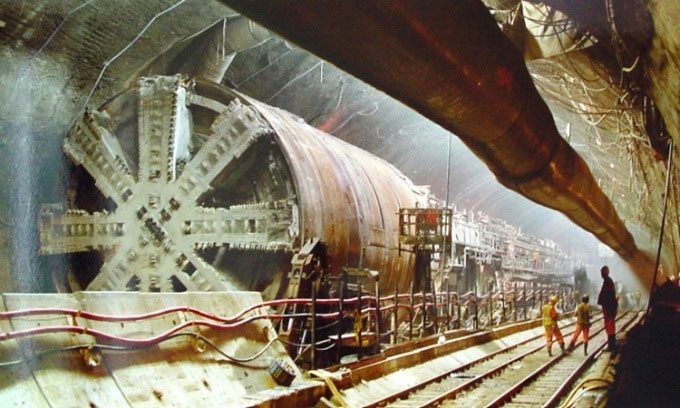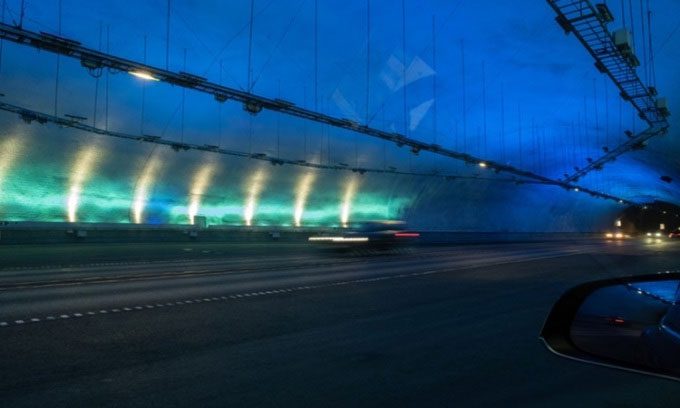Many of the longest underwater tunnels serve as a testament to modern engineering, acting as vital arteries for infrastructure in their regions.
Seikan Tunnel
Connecting Honshu and Hokkaido islands in Japan, the Seikan Tunnel is the longest underwater railway tunnel in the world. The project originated in 1954 when ferries were the primary mode of transportation between the two islands. However, after a powerful storm claimed 1,430 lives in the Tsugaru Strait in 1954, engineers sought a safer solution. Considering the unpredictable weather, they decided to construct a tunnel instead of a bridge connecting the two islands.
The tunnel was completed in 1988, stretching 53.85 km and located 240 meters below sea level. It includes two stations: Tappi Kaitei on Honshu and Yoshioka Kaitei on Hokkaido. These were the first underwater railway stations, serving as emergency escape points in case of a disaster. Today, the Seikan Tunnel primarily accommodates freight trains, making it a crucial hub for agricultural goods transportation.
Channel Tunnel

Channel Tunnel under construction. (Photo: Tambo / Wikimedia Commons).
The Channel Tunnel, measuring 50.49 km, connects Folkestone in the UK to Coquelles in France, lying beneath the strait of the same name. The UK and France collaborated on the construction of the tunnel beginning in 1986, opting for a railway tunnel instead of a lengthy bridge or a combined road-rail connection between the two countries. Initially, the then-Prime Minister of the UK, Margaret Thatcher, aimed to build a road tunnel instead of a rail tunnel. However, the road tunnel was deemed too dangerous, as rescuing people trapped in debris 24 km from the shore would be exceedingly difficult.
Construction began on both sides of the strait in 1987-1988, concluding in 1991, and the tunnel officially opened on May 6, 1994. Nowadays, the tunnel transports over 10 million passengers annually and more than 1.6 million trucks via rail service. The design of the Channel Tunnel comprises two railway tunnels and a service tunnel, facilitating two-way traffic.
Aqua Tunnel in Tokyo Bay
The Aqua Tunnel integrates both railway and road systems within a 9.6 km tunnel, connecting the cities of Kawasaki and Kisarazu across Tokyo Bay in Japan. Opened on December 18, 1997, its route includes several artificial islands, providing a unique travel experience. With two 10 km tunnels (Aqua Tunnel) beneath Kawasaki waters and a 5 km bridge (Aqua Bridge) in Chiba waters, the highway features two artificial islands positioned at the transition from tunnel to bridge.
Additionally, the Kazenotou ventilation tower is situated on the artificial island at the midpoint of the underwater tunnel. The Ukishima pyramid-shaped ventilation station near the tunnel entrance in Kawasaki enhances the design.
Ryfast Tunnel

Inside the Ryfast Tunnel in Norway. (Photo: Maurizio Fabbroni).
Located in Rogaland county, Norway, the Ryfast tunnel system comprises two tunnels with a combined length of 14.3 km underwater. The system features two dual-lane tunnels: the Solbakk or Ryfylke Tunnel running from Solbakk to Hundvag Island in Stavanger, and the Hundvag Tunnel connecting Hundvag to the underground motorway tunnel. As part of the E39 highway, the Ryfast Tunnel links the towns of Strand and Hjelmeland.
The construction of the tunnel system took a decade and involved excavating over 2.5 million cubic meters of rock. The Ryfast Tunnel holds the record for the deepest underwater road tunnel in the world, reaching a depth of 292 meters below sea level. Opened in 2020, the tunnel system replaced the Høgsfjorden ferry route.
Eysturoyartunnilin

The only underwater roundabout in the world. (Photo: Kristina Háfoss/Twitter).
Inaugurated in 2020, the Eysturoyartunnilin, or Eysturoy Tunnel, stretches 11.2 km beneath the North Atlantic Ocean. The structure connects the two largest islands in the Faroe Islands archipelago, Streymoy and Eysturoy. At its deepest point, this underwater tunnel is located 189 meters below the seabed. This unique network consists of three tunnels, but the most interesting part is the colorful intersection at the center of the tunnel, which is the first and only underwater roundabout in the world. This roundabout is a remarkable engineering achievement, illuminated with eye-catching colored lights and accompanied by music.




















































